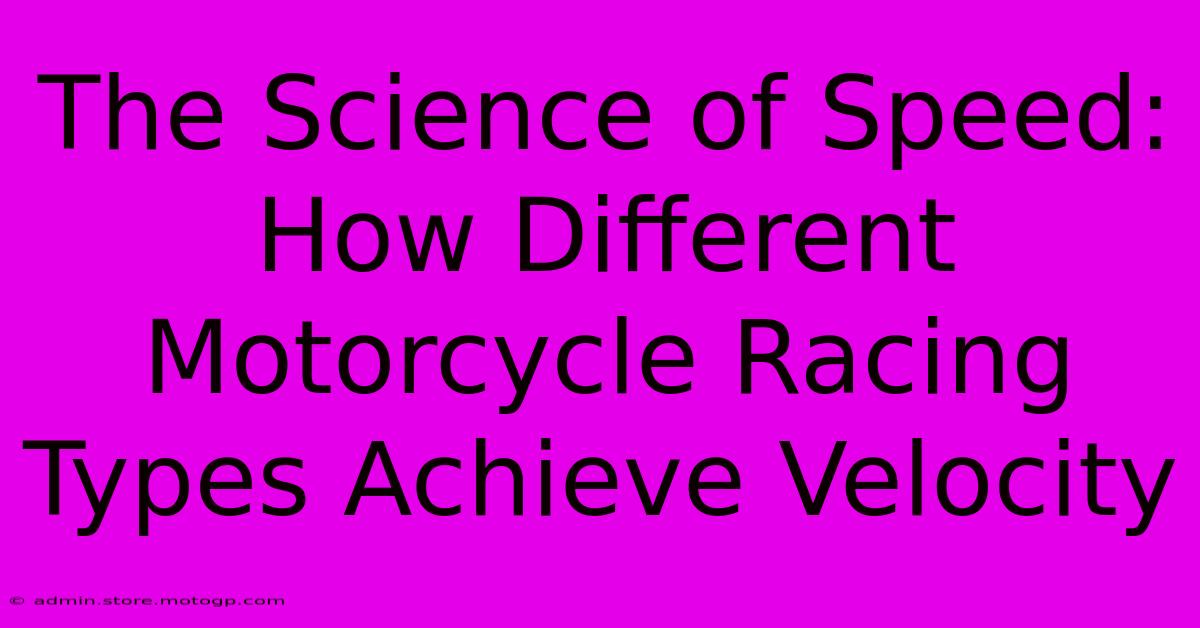The Science Of Speed: How Different Motorcycle Racing Types Achieve Velocity

Table of Contents
The Science of Speed: How Different Motorcycle Racing Types Achieve Velocity
Motorcycle racing is a breathtaking spectacle of speed, skill, and engineering prowess. But what makes one racing discipline faster than another? The answer lies in a fascinating interplay of factors, from engine design to aerodynamics and even rider technique. This article delves into the science behind the speed in various motorcycle racing types, exploring how each category pushes the boundaries of velocity.
The Engine's Roar: Power and Displacement
At the heart of any racing motorcycle lies the engine. Different racing classes have vastly different engine specifications, directly impacting top speed.
MotoGP: The Apex of Power
MotoGP, the pinnacle of motorcycle road racing, showcases the most powerful machines. These prototypes boast massive displacement engines (currently up to 1000cc), generating incredible horsepower. Their sophisticated electronics, including seamless gearboxes and sophisticated traction control, optimize power delivery for maximum acceleration and top speed on the track. The focus here is raw power and cutting-edge technology.
Superbike: Production-Based Powerhouses
Superbike racing utilizes modified production motorcycles, adhering to stricter regulations than MotoGP. While still incredibly fast, Superbikes have smaller displacement engines (usually around 1000cc) compared to MotoGP. The emphasis here is on refining and optimizing existing production technology to achieve high speeds. This balance between performance and manufacturability makes Superbikes more accessible and relatable to the average motorcycle enthusiast.
Moto2 & Moto3: Stepping Stones to Speed
Moto2 and Moto3 serve as stepping stones to the premier MotoGP class. Moto2 uses a standardized 765cc Triumph engine, focusing on rider skill and chassis development, while Moto3 utilizes smaller, 250cc four-stroke engines. The difference in engine displacement significantly impacts their top speeds, showcasing how engine size directly correlates to velocity.
Aerodynamics: Cutting Through the Wind
Aerodynamics play a crucial role in achieving high speeds, particularly at higher velocities. Every detail, from the fairing design to the rider's position, is meticulously engineered to minimize drag and maximize downforce.
MotoGP's Winged Wonders
MotoGP bikes are masters of aerodynamic efficiency. Sophisticated winglets and aerodynamic appendages generate downforce, keeping the bike glued to the track at high speeds, improving stability and cornering. This allows riders to carry more speed through turns, ultimately contributing to faster lap times.
Superbike's Subtle Aerodynamics
Superbikes, while not as aggressively aerodynamic as MotoGP machines, still utilize fairings and bodywork designed to minimize drag. The focus here is often on balancing aerodynamic efficiency with manageable heat dissipation, as production-based engines can produce significant heat.
Rider Skill: The Human Factor
While the machine is critical, the rider's skill is paramount in achieving maximum speed. Experienced racers understand how to maximize acceleration, navigate corners at high speeds, and maintain optimal body position to minimize aerodynamic drag. Their expertise translates directly into faster lap times and higher average speeds.
Tire Technology: Grip and Traction
The tires are the only point of contact between the motorcycle and the track. High-performance racing tires are meticulously designed for optimal grip and traction, allowing for maximum acceleration and cornering speeds. Advanced tire compounds and constructions are crucial in achieving and maintaining high velocities, especially during braking and cornering.
Conclusion: A Symphony of Speed
The pursuit of speed in motorcycle racing is a complex and fascinating interplay of engineering, technology, and human skill. By understanding the role of engine power, aerodynamics, rider skill, and tire technology in each racing class, we gain a deeper appreciation for the science behind the breathtaking velocities these machines and riders achieve. The continuous evolution of technology ensures the quest for speed in motorcycle racing will remain a thrilling and ever-evolving spectacle.

Thank you for visiting our website wich cover about The Science Of Speed: How Different Motorcycle Racing Types Achieve Velocity. We hope the information provided has been useful to you. Feel free to contact us if you have any questions or need further assistance. See you next time and dont miss to bookmark.
Featured Posts
-
The Evolution Of Moto Gp Horsepower A Historical Look
Feb 19, 2025
-
Moto Gp Points From Pole Position To Podium
Feb 19, 2025
-
The Biggest Circuit Race Events
Feb 19, 2025
-
Is Cota Lot H Right For You Find Out Now
Feb 19, 2025
-
Motorcycle Grand Prix Winners The Pinnacle Of Motorcycle Racing
Feb 19, 2025
